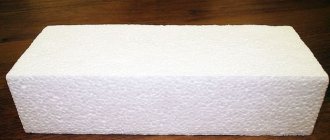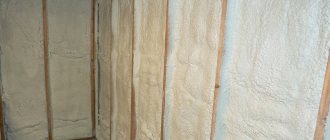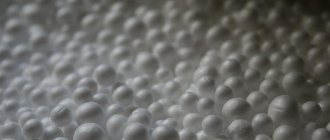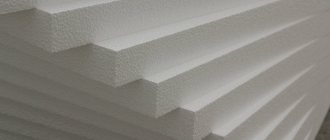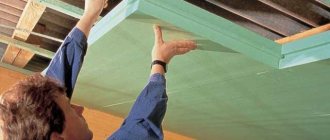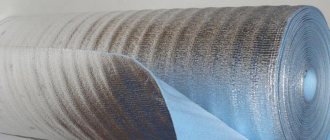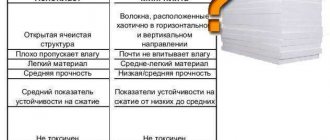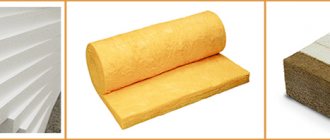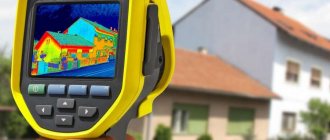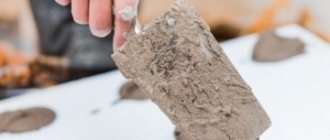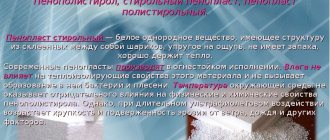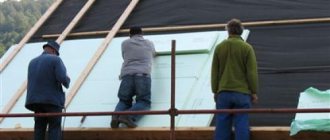Preface
.
In this article we will look at the issue of insulating a cinder block house from the outside with your own hands. Let's consider the choice of a heat insulator and the method of installing insulation on the facade - this will save money on heating a country house and make the climate in the house favorable for family living. The question of high-quality insulation of a cinder block house usually arises after construction. This is understandable, since the thermal conductivity of a cinder block ranges from 0.35 to 0.6 W/(m 0C). Such a significant scatter depends largely on the material of the blocks, as well as on its structure. Is it necessary to insulate cinder block walls and what kind of insulation - from the inside or outside of the house - is best to choose?
Is it necessary to insulate a cinder block house?
Do-it-yourself insulation of cinder block walls
Based on the characteristics described in the previous chapter, in order to ensure the thermal resistance of the walls according to SNiP 02/23/2003 in force in Russia, the thickness of cinder block walls should be in the region of 1.5 - 2 meters. It is not economically profitable to create such walls in the Russian climate.
It is necessary, in addition to the increased costs of constructing walls, to construct a powerful foundation. Therefore, the use of modern materials for thermal insulation will solve the problem - insulating a cinder block house from the outside will make the building warm, beautiful and will significantly save money on the construction of the foundation and walls.
Insulation from the outside and from the inside - pros and cons
When laying thermal insulation indoors, in winter the dew point moves towards the heated room and is located between the wall and the thermal insulation. Therefore, moisture, mildew and mold will form on the wall. Due to moisture getting on the thermal insulation, the properties of the material will significantly deteriorate. Additionally, you lose part of the living space when insulating a cinder block house from the inside.
Insulating a cinder block house from the outside saves living space, eliminates the formation of moisture and fungus on the walls; in addition, a cinder block house requires external cladding, which can be combined with insulation. The end result is approximately the same for both insulation methods, but we recommend using cinder block wall insulation from the outside; it is better not to use internal insulation.
Choosing material for cinder block walls
Without insulation, a cinder block house will be cold.
Before we talk about the method of insulating cinder block walls from the outside and inside, let’s decide on the materials:
- mineral wool (mats or heat-insulating cylinders);
- liquid thermal insulation (PPU, penoizol, insulating paint);
- expanded polystyrene (regular and extruded);
- penofol.
In addition to thermal insulation materials, special films are used. Before insulating a cinder block house, let’s look at the types of films (membranes) that are used to protect thermal insulation. There are three types in total:
- wind barrier - does not blow through, allows moisture and steam to pass through;
- waterproofing – protection from moisture, allows steam to escape from the thermal insulation;
- vapor barrier - does not let anything through.
It is important to lay the membranes on the correct side, otherwise they will not perform their tasks. In principle, the choice of thermal insulation largely depends on the conditions under which the thermal insulation will be used. For example, in a house or a bathhouse, because in the latter there is not only an increased level of humidity, but also very high temperatures, especially in the steam room. It is very important that the thermal insulation withstands high temperatures and does not emit toxic substances.
Modern quartz heaters for home, according to reviews, are very inert. They are positioned as economical, which is not entirely true, and the appearance leaves much to be desired.
You can read about which heater is more economical for an apartment here.
Materials for insulating a cinder block house
The most common way to insulate a cinder block house from the outside with your own hands is to lay mineral wool, glass wool, expanded polystyrene or extruded polystyrene foam (penoplex). First, let's consider the option of using mineral wool and glass wool.
Mineral wool and glass wool
Mineral wool and glass wool are produced in Russia in rolls and sheets. The properties of these materials are approximately the same, so we will consider them together. The advantages of the materials include low thermal conductivity of 0.041 W/(m 0C), high noise insulation, depending on the density of the wool. Basalt insulation has good fire resistance.
The disadvantages of mineral wool include poor moisture insulation - even with slight wetting, the insulation can lose up to half of its thermal insulation properties.
The procedure for laying the material is more complex. It is possible that individual parts in structures may sag when using roll insulation, and this can happen due to the dishonesty of contractors.
Expanded polystyrene and penoplex
Insulation of the exterior of a house with penoplex
Extruded polystyrene foam (penoplex) has a denser and stronger structure, the moisture absorption of the material is almost 10 times less. But these advantages of penoplex are offset by the cost - the price is significantly higher than that of polystyrene foam. In Russia, polystyrene foam is perhaps the most inexpensive and widespread material for insulating the facades of houses and walls in apartments.
Expanded polystyrene is produced in slabs. The advantages of both materials include a low thermal conductivity coefficient of 0.039 W/(m 0C), moisture resistance - does not lose its properties under the influence of moisture. The material is easy to use when laying on flat areas of the wall. Some types have fire resistance, allowing the material to extinguish in the absence of contact with flame.
Disadvantages include poor sound insulation, some types of foam have low fire resistance and are quite fire hazardous materials. Ordinary polystyrene foam is fragile; according to popular belief, small rodents and insects can live in the foam.
Methods for laying insulation
Laying mineral wool
When laying mineral wool, the surface must be primed
If you have chosen a material, but do not know how to insulate cinder block walls, follow our instructions. Since we are considering the option of insulating a finished house, the most acceptable option is “wet” installation.
For mineral or glass wool, the sequence of actions is as follows:
- Preparing the surface. At this stage, you should clean and plaster the cracks in your wall, as well as prime it. In addition, at this stage it is necessary to install a plinth to support the first row
- The next step is to prepare the glue for fastening. The preparation instructions will help you in this matter, as some compositions have differences in the preparation process.
- Then we apply glue to the slab of cotton wool and glue it to the wall. When gluing, it is worth remembering that there should not be cracks and gaps between the plates and it is best to overlap the joints or tightly hammer the cracks.
- Now we apply a layer of glue to the insulation and attach a fiberglass reinforcing mesh. We coat it thoroughly and let it dry for about a day.
- All that remains is to apply primer paint and plaster the surface. This can be done with either regular putty or decorative putty.
Laying polystyrene foam
Foam sheets should be laid without seams, as shown in the photo
The method of insulation with foam plastic is in many ways similar to the method of “wet” laying mineral wool. By the way, the insulation of the loggia is done in the same way.
To attach polystyrene foam:
- We are preparing the wall. To do this, we clean it and plaster the cracks.
- We prime the wall surface.
- Prepare the adhesive solution and apply waterproofing. It should protect the foam from moisture and thereby preserve its properties.
- Now we glue the foam sheets. At the same time, cracks should not be allowed, otherwise all the work has been done in vain.
- After gluing the sheets, we prime the surface and attach a reinforcing mesh to them.
- After the surface has dried, we prime it again and our wall is ready for putty.
- After applying it, you should have a wonderful, smooth surface that you can paint according to your wishes.
- Insulating your home will help you not only significantly increase your living comfort and reduce heating costs. Thanks to high-quality exterior work, you can give your home an attractive appearance and save on air conditioning, since such a house will also heat up less.
The video in this article will help you look at this topic in more detail.
Laying insulation on cinder block walls
Insulation of cinder block walls with mineral wool
Before insulating cinder block walls with mineral wool, the walls must be primed and cracks and cracks must be plastered, if necessary. The most common option is laying mineral wool with a ventilated facade and the “wet method”. We will consider the latter option in this article.
1
. Prepare the surface - plaster the cracks on the wall, prime the surface. Installing the first row of supports on the base will additionally protect the insulation from rodents.
2
. Preparing glue for attaching insulation. Then we apply glue to the slab and glue it to the wall. It is worth remembering that there should be no gaps between the plates and it is better to make the joints close together or fill the gaps with an adhesive solution.
3
. We apply glue to the insulation and attach the reinforcing mesh. Carefully coat the mesh with glue and let it dry completely within 24 hours.
4
. All that remains is to apply a primer and plaster the surface of the insulated façade with putty.
Insulation of cinder block walls with foam plastic
Sheets of foam plastic on walls should be laid without seams. The insulation method is similar to the “wet method” of laying mineral wool. Before insulating cinder block walls with penoplex, it is also necessary to prepare the façade of the house for work. Read on for detailed instructions.
1
. We prepare the wall surface - clean and plaster the cracks. We prime the walls and prepare the adhesive solution.
2
. We glue the foam sheets onto the façade in a checkerboard pattern. There should be no gaps - we seal them with glue or foam after installation.
3
. After finishing laying the foam sheets, we prime the surface and attach the reinforcing mesh to the glue, completely embedding it in the layer of glue.
4
. After the glue has dried, prime the mesh and putty it with regular or decorative putty.
After all the work, you should have a smooth surface that can be painted in any color. Insulation will help you significantly increase indoor comfort and reduce home heating costs. Thanks to external works, you can give the facade an attractive appearance. And in the video presented, you can learn more about the issue under consideration.
How to insulate a bathhouse or house made of cinder blocks
It is better to insulate cinder block buildings inside and outside.
To insulate walls you can use:
- foil;
- expanded polystyrene;
- polystyrene foam;
- mineral wool;
- basic insulation.
The choice of materials is quite wide and varied, so the choice of how and with what to insulate the walls of buildings made of cinder blocks depends only on you. It is worth noting that insulation will become more effective if you use different materials.
It is especially important to properly insulate the walls of the bathhouse so that they effectively retain heat. Good insulation will help reduce fuel costs.
Cinder block is an ideal material for building baths; it is not subject to rotting, it is not susceptible to fungus or mold. A bathhouse made of cinder blocks stands out for its fire safety.
But, although porous cinder blocks retain heat remarkably well, they easily absorb water. Because of this property, the cinder block loses all its positive qualities. Therefore, in order to prevent the formation of dampness inside the blocks, they are insulated.
Cinder blocks have gained wide popularity in the building materials market not only due to their low price, but also because all the necessary equipment for the production of cinder blocks can be purchased and made at home. The economic benefits of making cinder blocks yourself are quite obvious; in addition, you will not need to look for carriers to deliver the finished material.
However, we should not forget that any violation of production technology can lead to a deterioration in the technical characteristics of the cinder block. You can read about the main ones in this article.
Stages of insulation work
- wooden slats are placed on the interior walls;
- insulation is placed on the slats;
- they are covered with aluminum foil or foil film on top (this is another layer of hydro- and thermal insulation);
- wooden slats are stuffed onto the foil and finishing material is attached to them. The slats help create an air gap.
It is important to properly insulate and seal openings in places where walls and doors are installed, as well as corners. The insulation is secured with a dowel anchor, choosing a length that is twice the thickness of the insulation.
For external cladding, a ventilated facade is installed and the walls are also insulated, especially in the place where the steam room will be located. For finishing, you can use siding or other facing materials, but most often cinder block buildings are plastered on the outside.
Today, the construction market offers a new, modern method of insulating walls made of cinder blocks, which can be used both in a newly built room and in an old building.
Thermal insulating foam is introduced into the hollow cinder block through a pre-prepared hole or two, if the cinder block is double-hollow. The foam supply hose is inserted alternately into each of the holes. As a result, the building is insulated and sound insulation is increased by filling the voids with foam.
Visually it looks like this:
Video. How to insulate a cinder block house
Individual construction is gaining momentum in Russia. Of the large number of building materials, many choose cinder block. A house made of this material can be built in a short time and, most importantly, costs little money. The disadvantage of cinder block is its loose, porous structure. As a result, under the influence of temperature changes and moisture, it crumbles. To avoid this, a cinder block house is subject to interior and exterior finishing. In this article we will tell you how to insulate a cinder block house.
When choosing a cinder block for building a private house, be sure to ask what kind of filler the manufacturer uses. The strength of the material depends on the size of the fractions; the smaller they are, the stronger the cinder block. But even this does not negate the mandatory insulation of a cinder block house.
Internal or external insulation
How to properly insulate a cinder block house: from the inside or the outside? We have discussed this issue more than once and once again we will repeat that, according to technology, thermal insulation should be attached from the street side. Only in this case, you do not risk, along with transferring the dew point to the inside of the wall, getting a result worse than before insulation. There are situations when you have to install thermal insulation inside, for example, in a steam room, because by insulating a cinder block bathhouse from the inside, you will protect the walls from moisture, which is also very important. Concrete blocks in conditions of high humidity will last much less.
In addition, insulating a cinder block house from the outside is necessarily accompanied by a calculation of the thickness of the insulation. In each case, this indicator will be different, the result is affected by:
- region of your residence;
- wall thickness.
During the construction of walls, the blocks are placed on edge or laid flat, and in one row. It turns out that there is no air buffer zone, as with brickwork. Practice has shown that even if you choose the largest blocks, such buildings cannot do without additional thermal insulation.
There are many types of heaters for the home, which one to choose among this abundance? For residential premises, the best option is a convector.
It is written here about why liquid fuel heaters cannot be used for home use.
Insulation of a cinder block house
When preparing to build a house, select in advance the material with which you will insulate the structure. To use any insulation, lay a wide base. This will give you the opportunity to work with any material, which can then be hidden under the finishing brick.
If you could not foresee this, then the only way out is to decorate the walls with plaster or install siding on them. Do not forget that when using these materials, thermal insulation must be made from sheets of foam plastic or fiber insulation.
Experienced craftsmen claim that exterior finishing, done according to all the rules, guarantees an economic effect of 70%, so in some cases interior finishing is not necessary.
Note!
If you are insulating a cinder block house immediately after its construction, then you should not neglect installing a vapor barrier layer indoors. Moreover, they need to insulate not only the walls, but also the ceiling.
Install a vapor barrier layer and insulation on the outside of the ceiling. To do this, use polystyrene foam or mineral wool. The finishing of the external walls of the house does not require the installation of vapor barriers.
Note!
If you have built a house with a basement or basement, then their walls and ceilings also require the installation of vapor barrier and insulation layers.
Mineral wool is attached to the walls using plastic or wooden slats.
Is it necessary to insulate a cinder block house?
Construction of walls of the required thickness significantly increases the estimated cost due to the need to strengthen the foundation and increased consumption of cinder blocks. This method of heat conservation worsens the appearance of the building and increases the cost of its construction.
Door and window openings, deeply recessed into the walls, look very strange. An insufficient amount of daylight penetrates into the house through the windows, which causes not only increased energy consumption to illuminate the interior, but also discomfort for the people in them.
Insulating walls allows you to reduce their thickness. After installation of thermal insulation, decorative finishing is carried out, giving the building individuality.
Painting or siding
The most affordable and cheapest option for insulating a cinder block house from the outside is installing foam plastic slabs, finishing it with plaster and then painting it. If you are dealing with an old house, then you need to carry out repair work. Seal all cracks and uneven areas. Then you insulate the walls with foam plastic. Secure them with dowels 2 times larger than the thickness of the foam sheet.
A more modern insulation material is polystyrene foam, made from the same raw materials as polystyrene foam. The effect is produced by a different production technology. Both of these materials have the same thermal conductivity, but polystyrene foam has much lower water absorption. When insulating with this material, there is no need to install a vapor barrier layer.
Stages of work on insulating a cinder block house:
- Wall plastering work.
- Foam fastening.
- Installation of reinforced mesh.
- Leveling, priming and finishing walls.
- Painting.
Note!
If your project involves painting the walls, then most likely you will need to use acrylic or silicone plaster, but the latter will cost you much more.
The advantage of acrylic plaster is that it is applied in color. Mineral plaster needs to be painted after application. Painting will have to be repeated every 3 years. Colored plaster will last you a very long time; it is usually painted when you want to change the color of the house.
If you have the financial means, insulate your house with mineral wool, which you then cover with siding.
Insulation of a cinder block house from the outside, technology for performing the work
Cinder block is a universal material that allows you to quickly build a large stone house. At the same time, these huge blocks are not suitable for every climate, so it is often necessary for such houses to insulate the walls from the outside. This material is made from the so-called slag concrete - a mixture of cement and slag crumbs, which is formed when iron is smelted from ore. The slag itself is durable, porous, and the block itself has a sufficient number of holes to provide high-quality thermal insulation. Often, due to violations of construction technologies, the house does not meet the owner’s expectations, so additional insulation is required. This is worth doing in any case, if only because it will result in significant savings on energy resources. This article will describe how to insulate a cinder block house, namely, the main steps, as well as materials and construction technologies.
Material selection
Let's look at the two main types of insulation that are most suitable for cinder block walls.
The first type is mineral wool or glass wool. Using this insulation, you can cover walls both outside and inside, and you can also use it to insulate floors in rooms on the basement side. It is stuffed either using special staples, or into a network of boxes, which are then sheathed on top with some material. The main advantage is that there are no pests in it, and the area closes very quickly. This is a budget option that is much more affordable than the next type of material.
The second type is foam polymer materials made in the form of sheets of varying thickness. The most popular are polystyrene, polystyrene foam and penoplex. Experts often consider them to be one and the same material; the only thing that stands apart is ball foam, which is the cheapest of these materials for wall insulation. These materials are often used to insulate only the outside.
The second type is preferable, but usually people look at their financial capabilities. All these materials are good.
Selecting insulation thickness
Insulation of a cinder block house will be successful only when the correct thickness of wall covering is selected. Exact calculations are quite complicated, but based on experience, we can say that the best thickness for insulating the outside of houses in Russia is a thickness of 10 centimeters. In this case, it is necessary to take into account not only the thickness of the insulation, but also the thickness of its coating - plaster or sheathing panels. For the southern regions of our country, you can make a thickness of 5-7 centimeters. The best advice will be obtained from those who already use such a house and have lived in it for at least one winter. The thickness of the walls of the house also plays a role. A house made of slag concrete can also be cold due to an improper foundation, and then it will also have to be insulated, but this is a completely different area of work.
https://youtube.com/watch?v=ddM14gqXnRg
Before starting insulation from the outside or inside, it is necessary to check the walls for cracks or uneven filling of the seam, and correct all this, otherwise the procedure will not give the desired effect.
Step-by-step instruction
In order to insulate walls made of slag concrete, it is necessary to perform a series of works sequentially. Let's consider the procedure for performing work for sheet materials.
- Preparing the walls outside. It is necessary to brush off the dust, remove lagging fragments with sandpaper, holes and potholes must be carefully leveled. After this you need to start priming. The primer must be viscous, otherwise the cinder block will absorb it, and then you will have to fork out for this simple step.
- Applying glue and pasting the walls with sheets of material. You need to press the sheets tightly, and after the glue dries, you need to carefully coat all the seams.
- Installation of fasteners. Using special dowels, foam sheets are pressed against the wall for greater insulation strength.
- A fiberglass reinforced mesh is glued to the surface, which should be applied to the entire plane of the insulation. A special glue is used for it, and it is rolled out from rolls with a roller over the surface.
- Applying a protective layer. It is usually a flexible, cement-based polymer mixture. The surface is leveled.
- Plastering the surface. This is just a decoration; usually it does not carry any power load or thermal insulation functions.
- As for mineral wool, a frame is assembled using quick fastening, which is filled with pieces of insulation, and then the entire frame is covered with decorative finishing - clapboard, thin siding or even profile laminated iron sheets.
Spray insulation
Insulation of the house is done in order to minimize heat loss. Manufacturers do not stop and are constantly searching for new insulation materials. One of these new insulation materials is polyurethane foam. You can use it in the form of insulating spray or filling.
The mixture, consisting of two components, is sprayed using special equipment and a gun. As a result, you will have a coating without seams; cold air will not be able to penetrate through it at the joints of the cinder blocks.
You can use polyurethane foam for external and internal insulation. In addition, the material, in addition to insulation, provides walls with a vapor barrier, increases the reliability of structures and protects wooden parts from rot. Polyurethane foam insulation, according to manufacturers, has a service life of 30 years.
The use of cinder blocks in the construction of structures is economically beneficial and the dimensions of the material elements allow achieving high speed of construction of the walls of the house. But its insufficient thermal insulation properties and the ability to lose strength under the influence of critical temperatures forces thermal insulation, with the help of which the required level of durability of the structure will be achieved, as well as the ability of the structure to accumulate heat will be increased.
External insulation
We will begin to consider methods of insulating a cinder block house with external thermal insulation. Experienced specialists, whose field of activity is the insulation of buildings, claim that external finishing of cinder block walls with thermal insulation materials increases the ability to retain heat by 70%. Therefore, it is precisely this solution to the problem, which can reduce the thermal conductivity of the building frame, that will achieve a good result.
In most cases, the exterior of cinder block walls is finished with foam.
The purchase of material implies a minimum level of costs (if you take into account the cost of polystyrene or penoplex), in addition, its thermal conductivity allows you to achieve a high thermal insulation effect.
Please note that if the ability of the walls to let air through (breathe) is important to you, then it is better to replace polystyrene foam with mineral wool.
External thermal insulation with such material has another great advantage - ease of work. It is enough to attach the foam to the wall surface using dowels. The length of the latter must be selected based on the thickness of the sheet. The length of each dowel should be equal to twice the width of the foam.
Insulation scheme with mineral wool or polystyrene foam on glue
It should be taken into account that insulation with foam plastic from the outside requires that each sheet fits as tightly as possible to the wall surface. If the latter has some unevenness, then you can simply use additional glue during installation, which will help compensate for this deficiency. If damage appears on the cinder block wall before insulation, the surface must be puttied.
Conventionally, the entire insulation process can be built in the following algorithm:
- Leveling the surface (putty).
- Fastening insulation sheets.
- Installation of reinforcement mesh.
- Second alignment.
- Primer.
- Preparation before painting – finishing with “Finish”.
Insulation with mineral wool under siding
If you plan to paint the walls after insulation, you should use acrylic or silicone plaster to level the surface.
Insulation of the outside of a cinder block house can be done with mineral wool, but this will require additional financial investments - it is difficult to prepare such a surface for painting, so this means covering the walls of the house with siding or other facing elements.
External insulation method
Wet façade technique.
External insulation of a cinder block wall is performed using two methods:
- wet facade;
- ventilated facade.
Before you insulate a cinder block house from the outside, you should decide on a methodology to make it easier for you to figure out what will be more profitable. A wet facade is the application of plaster directly on top of the insulation. This method is possible using mineral wool or polystyrene foam (regular and extruded). The density of wool must be at least 50 kg/m. cube, foam plastic not less than 25 kg/m. cube, a larger error is welcome.
How to insulate a cinder block house from the outside using the wet facade method:
- the wall must be smooth and primed;
- The thermal insulation is glued to the wall and fixed with dowels;
- a layer of putty is applied, a reinforcing mesh is embedded in it, a special plastic corner is used at the corners;
- a second layer of putty is applied on top;
- the surface is primed and painted.
Mineral wool is glued to universal dry construction adhesive, which must be diluted with water, and can also be used to putty. Polystyrene foam, in addition to such glue, can be attached to adhesive foam - similar to mounting foam, but intended for polystyrene foam boards.
If the insulation is laid in two layers, then the slabs of each layer must be secured with dowels, because they will be subject to the load not only from the weight of the thermal insulation, but also from two layers of putty. Naturally, all seams are foamed and they should not match. Do not ignore slopes; cold air enters the room through them.
Ventilated façade technique.
The ventilated façade technique involves constructing a structure from the outside, where the thermal insulation layer will be blown through. This is necessary to remove all possible condensation and for cooling, which is convenient in the hot summer. The technique can be used:
- mineral wool;
- polystyrene foam with its derivatives;
- liquid thermal insulation;
- ecowool.
First, the first level of sheathing is erected, then the thermal insulation stage. Mineral wool and foam plastic are glued, and ecowool, polyurethane foam and penoizol are sprayed onto the wall using a compressor. Afterwards, any film is laid, which should first of all be a wind barrier, and if it still does not allow moisture to pass through, this is only a plus. The next level of sheathing is built on top of the film, which is necessary so that there is a ventilation gap between the thermal insulation and the finishing. In the buffer air zone, flows always circulate from bottom to top, like an exhaust hood. Given this fact, special attention should be paid to the degree of flammability of the materials used. You should choose non-flammable insulation materials, which we already wrote about once.
Internal insulation
If you listen to the opinion of experts, it is preferable to carry out all insulation processes outside the structure. But this possibility is not always present, and external insulation does not always allow achieving the desired level of energy efficiency of a building.
The inside of a cinder block house is insulated using the same polystyrene foam or mineral wool.
Using the first will simplify the work and allow you to achieve high thermal insulation performance of the walls. In addition to high efficiency, it has disadvantages:
- The thickness of the material will reduce the internal space of the rooms.
- The very fact of its flammability and the release of harmful substances during combustion reduces the fire safety of the building.
- Some substances contained in its composition must be kept away from the human environment.
As for mineral wool, it does not contain substances harmful to the body, and pests do not breed in it. The material is also characterized by low flammability, small thickness and cost-effectiveness. Its main disadvantage, which can be called an advantage, is the ability to let air through. If the walls of a house are covered on both sides with such insulation, the house will “breathe,” but the level of thermal insulation characteristics will decrease.
Installing polystyrene foam is no different from insulating walls outside. The mineral wool is secured with special staples. If we take into account the choice of the majority, then preference is given to the second option, which is environmentally friendly and economical.
Advantages of external insulation
When building a house from cinder blocks, most owners prefer to insulate it from the outside. This is due to the advantages of this method:
- The insulation installed outside reliably protects the walls of the house from fluctuations in air temperature. The absence of exposure to temperature changes on the wall material (freezing and subsequent thawing) significantly increases their service life.
- Placing thermal insulation on the outside of the wall changes the location of the dew point so that moisture does not condense in the inside of the wall, but evaporates from the surface of the material.
- The decorative finishing of the thermal insulation layer becomes an additional protection for the walls from the effects of negative external factors (snow, frost, rain and ultraviolet radiation).
- External insulation helps the walls accumulate heat received from heating the room. This property of cinder blocks makes it possible not to use additional heating during a short-term drop in temperature.
- Installing insulation on the outer surface of cinder blocks preserves the usable area of the premises.
How to choose the thickness of insulation?
The effectiveness of insulation depends not only on the selected material, but also on the thickness of the thermal insulation layer.
In order to make an accurate calculation, you need to take into account the totality of the characteristics of the cinder block, insulation, as well as the climatic conditions of a particular region. Therefore, to simplify orientation, we present data based on the long-term experience of builders:
- The optimal level of thermal insulation thickness throughout Russia is 10 cm.
- In the southern regions, a layer of 5-7 cm is sufficient.
For a more accurate calculation, contact a specialist or ask for advice from local construction companies.
Insulation using a spray solution
In order to simplify the thermal insulation process and achieve its high efficiency, modern insulation methods are being developed. These include treating walls with a special material – polyurethane foam. In addition to reducing the thermal conductivity of walls, it functions as a protective coating, which greatly simplifies and speeds up surface treatment.
Its peculiarity is that there are no fastening elements, which creates the effect of a continuous coating, without the presence of “weak points”: seams, dowel installation points, etc. The use of polyurethane foam is possible for the purpose of external and external thermal insulation.
It is worth noting that the sprayed surface will already have the most even structure for further processing, and the small thickness of the material will preserve the internal space of the structure and reduce the cost of purchasing external finishing elements.
The disadvantages include cost, but in some cases the use of sprayed thermal insulation will even be economically beneficial (if you take into account the additional characteristics of the material). The manufacturer also claims the durability of the coating (about 30 years), but the product is new and there is no actual confirmation of such statements yet. When choosing a material for insulating a cinder block house, pay attention not only to the allocated budget, but also to the compliance of the material with the needs of a particular case. You should also not forget about the advice of experts and the level of harmful substances in some insulation materials. Always try to insulate the exterior first, and only then, if absolutely necessary, insulate it from the inside.
Regardless of what material the house is made of, it always requires insulation. Therefore, taking into account the material of construction, one or another insulation material should be selected. To insulate a cinder block house, you must first decide on the possible options, their installation technique and, of course, cost.
Here it should be taken into account that when coming from the inside, the dew point will move and stop between the wall and the coolant. As a result, moisture will appear on the surface, which will inevitably lead to fungus. And this, in turn, has a detrimental effect on the quality of thermal insulation of the house, not to mention the loss of usable space inside.
Therefore, by insulating the house from the outside, all these negative aspects are avoided. In many cases, experts note that this method is even better compared to work on internal walls.
Main types of insulation
Today there are two optimal options: mineral wool (or glass wool) and polystyrene foam. Each of these materials has its own positive and negative qualities.
Mineral wool is produced either in rolls or sheets. The material has the following positive aspects:
- the thermal conductivity indicator has a value of 0.041 W/(m°C), this characteristic may vary depending on the density of the material itself, but such a change will be insignificant;
- good sound insulation, here the density is of significant importance;
- fire resistance: if a fire occurs, then in the absence of open fire the material will quickly extinguish;
- ease of fixation: the structure of mineral wool allows you to easily cope with uneven surfaces, and it is also easy to eliminate voids.
But this material also has disadvantages:
- poor moisture insulation: if such cotton wool gets wet, the thermal insulation will deteriorate by 2 times;
- the installation technology itself has more complex features;
- rolls tend to roll, this factor is influenced by the dishonesty of contractors or improper insulation of cinder block walls on their own.
Polystyrene foam (extruded polystyrene foam), unlike the first option, is more dense in structure, which makes it more durable. The level of moisture absorption is approximately 10 times lower than that of mineral wool. But all qualities are significantly reflected in the price of the material.
Polystyrene foam can be presented in the form of slabs, less often in rolls.
The positive aspects of this material include the following:
- good resistance to moisture: even if water gets on the surface, the walls will not lose their thermal insulation properties;
- applicable on flat areas and covers them well;
- depending on the use of certain brands, it may have good fire resistance, therefore, like mineral wool, if there is no open fire near the source, this material will quickly extinguish.
Among the negative aspects, the following characteristics should be highlighted:
- low level of sound insulation;
- some types of foam plastic absolutely do not tolerate fire, therefore, when insulating the walls of a house, you should carefully select the brand, otherwise during a fire it can emit acrid smoke and support the fire itself;
- This material of the usual type has a rather fragile structure, this, in turn, leads to certain installation problems.
There is an opinion that rodents like this material. But it is not so. Rodents do not eat polystyrene foam, but they make their home in it, since it is warm enough.
Return to contents
Plastering cinder block walls
Plaster for external use has the following positive qualities:
- prevents moisture from entering cinder blocks;
- has heat-insulating properties;
- fills seams and hides block defects, potholes, protruding ends of reinforcement;
- helps to decorate the facade.
Low prices are also important; any other finishing wall cladding will cost several times more.
Subsequently, repairs to plastered surfaces can be easily carried out. Preparatory plastering work is quite labor-intensive, and the process itself is very dirty. You need to take care of scaffolding in advance.
Types of plaster compositions and their features
External work should be carried out only with cement-sand mortars; they can be purchased in the form of dry mixtures at any hardware store. The most popular plaster brand is Knauf.
You can prepare the mixture yourself; to do this, you need to take the bulk materials separately and mix them dry before pouring water.
Typically, the solution ratio is made in the proportions of 4 parts sand and 1 part cement or gypsum. But for street work it is better to make a ratio of 3:1.
The consistency of the finished composition should resemble thick sour cream; such a solution will stick well to the walls and stay on them. Next, you can begin plastering work.
Plaster mixtures are:
- cement-sand;
- gypsum;
- limestone;
- special compounds.
To make the coating durable, good, dry weather is important for plastering work. The ability to properly dilute the composition is also important. You will also need quality tools.
How to properly plaster cinder block walls
- Before applying the solution, the wall must be thoroughly moistened with water. You can do this using a wide fan, spraying water with it.
- Plastering begins from the upper corner of the wall, slowly moving sideways and down. Professionals call this method “square-nested”. The size of the square may vary, but if you have no experience in plastering, it is better to make it smaller.
- The wall is gradually completely covered with mortar; there should be no gaps or omissions left on it.
- After the wall is covered with mortar, the excess is removed.
- Grouting procedures are carried out. To do this, use wooden or plastic graters. Movements when grouting should be uniform and measured.
- To create a beautiful relief surface, you can put a layer of decorative plaster on top of the plaster.
The video shows plastering a wall using beacons:
How to insulate a cinder block house from the outside with mineral wool
Before you start insulating the walls, you should prepare them.
To do this, they are coated with a primer. If you are already completely ready, and all that remains is to start insulating the walls, then a method called wet installation will do.
In order to insulate a house, you need to follow these steps:
- Prepare the surface of the cinder block wall. It is cleaned of dirt, after which the cracks are removed by plastering and primed. At the same stage, you should take care of the base, which will serve as a support for the first row.
- Next, an adhesive solution is prepared onto which the insulation will be attached to the walls of the house. This process can be found on the product label. After the glue is ready, it is applied to the surface of the material, and then it is pressed against the wall. At this stage there is a very important point: it is best to overlap the masonry to avoid the formation of gaps between the slabs. Otherwise, you will have to take care to fill the cracks tightly.
- After the cinder block house is covered with material, you should take care of the reinforcing mesh. It is made from fiberglass. To attach it to the wall, it must be coated with glue and allowed time to dry completely (24 hours).
- The final stage of such work is the application of primer paint to the walls or plaster. In the latter case, both ordinary and decorative putty are used.
In general, there is nothing complicated about insulation. Everything is elementary and simple.
Return to contents
How to insulate cinder block walls from the inside
The steam room in the bathhouse is insulated from the inside.
Internal insulation of a cinder block house is not recommended, unless, for example, you can use special paint with ceramic hollow spheres or penofol as additional thermal insulation. They are ineffective as independent materials. Thermal insulation of cinder block walls from the inside is practiced in steam saunas, when it is additionally necessary to protect the walls from moisture. In this case, the main thing is to prevent moisture from the steam room from getting into the insulation layer. Naturally, you can only use mineral wool. Work method:
- a wooden frame is erected on the inside of the walls in the steam room;
- Mineral wool, preferably basalt, is placed between the guides;
- foil insulation is spread over the sheathing - it is very effective for saunas, as it blocks infrared radiation and does not allow steam to pass through;
- a second tier of sheathing is installed on top of the foam foam;
- A wooden lining is attached to the second tier.
Mineral wool needs to be laid in two layers and ensure that the joints do not coincide. The minimum insulation layer is 10 cm. The main thing is not to forget to glue the foam foam joints with special (not stationery) tape. Also, the ventilation gap between the penofol and the wooden paneling should not be neglected. Without it, reflective insulation simply will not work, and besides, the condensation on the foam foam must evaporate. Penofol foil often has small holes that are invisible to the eye. Therefore, to be on the safe side, you need to lay a vapor barrier membrane under the penofol.
How to insulate a cinder block house with polystyrene foam: features
The method of laying polystyrene foam is in many ways similar to the method of insulating walls with mineral wool. The sequence of actions is as follows:
- First of all, the wall must be properly prepared. As in the first case, the surface is completely cleaned, puttied and primed.
- Next, glue is prepared according to a similar scheme and according to the instructions on the package. It is also necessary to take care of waterproofing, as it will provide protection from water.
- The wall of the house is covered with overlapping material, without allowing any cracks.
- After the wall is ready, it is reinforced with mesh. Next, give it time to dry and prime.
- The last stage is puttying the cinder block walls. Then you can start painting.
The insulation procedure is important from the point of view of the comfort of life in the house, and also helps to save on heating.
No matter what material the house is built from, the owner always tries to reduce the cost of heating and repairs. An excellent solution to such problems is the installation of insulation.
It is especially important to carry out such measures as quickly as possible if the structure is made of material that does not retain heat well. Therefore, today we will look at the insulation of a cinder block house from the outside.
Qualified craftsmen advise insulating a cinder block house from the outside, since this option has many advantages:
- Extends the service life of the main structure. External thermal insulation must be protected from external influences. The trim not only becomes a barrier to the insulation, but also to the cinder blocks.
- Saves usable space in living spaces.
- Protects against the formation of dew on the walls of the house, and therefore prevents the appearance of fungus or mold.
- Allows you to save up to 70% of heat. Internal walls accumulate heat and release it back when the air temperature in the room drops.
Why choose external insulation?
Professional builders recommend thermally insulating a cinder block house from the outside due to the numerous advantages of this method:
- Extending the service life of the main structure. Insulation installed outside will require mandatory protection from various external influences. Finishing materials will not only create a barrier to thermal insulation, but will also protect the cinder blocks.
- The usable area of the main living quarters will be preserved.
- The walls of the house will be reliably protected from condensation, which will prevent the occurrence of mold and mildew.
- Thermal insulation of your home will allow you to save about 70% of heat. The internal walls will become a kind of heat accumulator, and when the air temperature inside the room decreases, they will actively release it back.
Choice of insulation
Houses made of cinder blocks do not retain heat well, so either polystyrene foam (or its cousins) or mineral wool are chosen as insulation. Each option has its own advantages and disadvantages. Let's take a closer look at each of them.
Styrofoam
If the question arises of how to insulate a cinder block house from the outside and spend a small amount, then it is better to use it. The material has excellent technical characteristics, but several shortcomings cause slight concern. Therefore, it is important to study all the positive and negative facts before choosing polystyrene foam for insulation.
Advantages:
- The smallest thermal conductivity coefficient.
- Light weight, which makes it easy to transport and install the material yourself.
- Low moisture absorption rate. Even if the foam is completely immersed in water, it can absorb only 4% of its own weight, and this is an excellent indicator.
- The material is not affected by mold, fungi, or insects.
- Long service life. If the foam is reliably protected from external influences, it can last up to 50 years.
Now let's look at the disadvantages:
- The insulation does not allow steam to pass through. The effect of a thermos is created. Heat is retained inside the house both in winter and summer.
- Low temperatures combined with a small amount of moisture destroy what you have made with your own hands.
- Before starting installation, you need to level the base.
- Toxicity when burning. But for cinder block walls this drawback is not so important. Polystyrene foam burns only in the presence of a constant source of fire. In this case, there are no components of the structure that could quickly ignite and burn for a long time.
- Rodents love to make their homes in polystyrene foam.
Minvata
You can also insulate the house with mineral wool. Moreover, without unnecessary fears, you can choose any type of material proposed and get a good result. Qualified specialists recommend using this particular option for arranging thermal insulation for the walls of a cinder block house.
The main advantages of this insulation:
- Low thermal conductivity coefficient.
- Possibility to create additional sound insulation.
- Fire resistance.
- Can be mounted on walls with slight unevenness.
- Environmentally friendly.
The disadvantages include:
- High moisture absorption coefficient. Mineral wool must be treated on both sides with water-repellent glue. Difficulty in installation.
- If you lay and fasten mineral wool incorrectly, then in some places it may mat (shrink), which will lead to a decrease in thermal insulation properties.
Having become familiar with all the positive and negative aspects of using one or another insulation, each owner will choose the option that, in his opinion, is the most optimal.
Brief summary
Before you insulate a cinder block house from the inside, remember the parting words of heating engineers: “Only external insulation gives good results.” Work inside is carried out only if it is necessary to protect the walls from the destructive effects of moisture, for example, in a steam room. In houses, internal thermal insulation can be an addition to the external one, nothing more. From the street side, a house can be insulated using two methods: wet and ventilated facade. Before work, always consider which layer of thermal insulation is needed specifically in your case.
Installation
Once the appropriate material has been selected, the question arises: how to insulate a cinder block house from the outside? If a person is far from the construction business, then it is advisable to use the services of professional teams, but you can do everything yourself. The main thing is to strictly follow the chosen instructions.
Each insulation has its own technology for constructing a thermal insulation structure. Therefore, we will not consider a generalized picture, but will propose a work plan for each option separately.
Insulation using foam plastic
Any process begins with a preparatory stage. It is definitely present when installing foam plastic.
- Protruding elements are removed from the base. This may include excess mortar, fasteners and hanging structures (antennas, drainpipes).
- If there are deep potholes, cracks, or broken pieces of cinder block, you should get rid of them. To do this, the surface is plastered.
- When the layer of plaster has dried, you need to apply primer. Such measures will help increase adhesion (adhesion of the adhesive solution and the base) and protect the wall from mold.
Only after the primer has completely dried can you begin installing the foam.
- The first step is to install a starting galvanized or stainless steel profile. It serves as a support for the entire structure. It is necessary to correct the horizontal. A building level is suitable for this. If there is even the slightest distortion, it can cause deformation and even collapse of the insulated and finished facade. The profile is attached to dowel nails.
- Next, prepare an adhesive solution that is suitable for outdoor use and for foam plastic. If you buy the first one you come across and do not read the instructions, then the consequence of such a rash step may be a poor-quality facade that will peel off from the cinder block walls. Before cooking, be sure to read the instructions; manufacturers indicate the exact quantities of ingredients.
- The glue is applied in small blots at the corners of the foam and in the center.
- The first insulation board is laid with its lower edge in profile towards the lower left corner of the building. It is necessary to press the element a little and move it from side to side so that there are no voids left.
- The next sheet of material is coated with glue in the same way, only the composition is also applied to the end part. Press the part tightly against the first one so that there are no gaps or cracks between them.
- The second row is laid so that the joints do not coincide. To do this, the slab is shifted a third or half to the side. In the same way, insulation is carried out over the entire area.
- After the glue has dried, you also need to fix the foam mechanically. This will make the structure more reliable. You will need dowels with a wide head. The approximate number of fasteners is calculated as follows: 5 pieces are needed for one slab.
- Now you can move on to the façade cladding.
Mineral wool
The installation process of this insulation is a little more complicated, but it all starts with preparation. The base is cleaned of stains, dust, dirt, and protruding elements. It is not necessary to plaster the surface; it is enough to seal deep cracks and treat the walls with primer.
Then a metal profile is installed to create a support. Next, prepare the adhesive solution according to the instructions indicated on the package. The glue is applied in a thin layer to the entire surface of the slab (it creates a water-repellent layer), and then several small blots are made in the corners.
The material is pressed tightly against the wall. There should be no joints or gaps. It is also not advisable to do it with a whip. They start doing everything from the bottom left corner. The slabs are glued according to the principle of brickwork.
After the mineral wool has completely covered the walls, you need to glue the reinforcing mesh. The same adhesive solution is applied to the surface of the slabs and fiberglass is embedded in them, smoothing it with a spatula. After this layer has dried, you can begin decorating.
Insulation options
This is not to say that cinder block is a completely ideal material. It is characterized by some disadvantages. For example, the material does not tolerate dampness, especially if the insulation is of insufficient quality. The structure freezes, and then, when it thaws, the cinder block can crumble. That is why it must be insulated. Today, there are several technologies that answer the question of how to insulate a cinder block house from the inside or outside.
Cinder block house requiring insulation
Before starting work, you need to clearly understand: it’s just cold in the house, or the walls of the house are really freezing and damp. The process of insulating the outside of a building can be carried out using the methods described below.
Ventilated facade
The ventilated system consists of stacked elements connecting to a single façade structure. A high-quality system is characterized by ideal placement of existing finishing elements located in the same plane with the facade .
In this case, the gap that forms between two adjacent panels can be minimal or pronounced. Installation of panels with gaps will allow you to hide various flaws in the work, as well as, if necessary, adjust the finishing elements.
Some types of systems provide 3D adjustment, thanks to which you can perfectly align the plane of each element relative to the adjacent one.
Insulation layers of a ventilated facade
Using a special material, façade sealant, you can seal the joints between ceramic tiles yourself. After this, the seams must be covered with ceramic chips.
It is especially important to correctly calculate the thickness of the ventilation gap.
Note! Different types of systems are able to provide gaps of different thicknesses.
This parameter directly depends on the thickness of the insulating material used. However, the limit norm is considered to be 100 mm; otherwise, too much traction occurs in the formed space. It is extremely undesirable in case of fire.
Advantages of installing a ventilated facade
Note! The minimum gap width that can provide effective ventilation of walls is 20 mm. In the case of a one-story building, it is better to increase the gap to 4 cm, then the required volume of ventilation will be ensured.
The instructions for most systems for installing facades imply the following procedure:
- surface marking;
- fastening guides;
- installation and fixation of insulating material;
- installing a windproof membrane on top of the insulation;
- installation of sub-cladding structure;
- laying facing material.
Note! The insulation material must be securely fixed, otherwise the insulation boards are likely to slip, which will lead to the formation of cooling sections of the wall.
Two-layer mineral wool insulation materials are fixed with the harder side of the building, which ensures an excellent fit of the slabs with the soft side to the surface of the building wall. At the same time, the outer side of the structure will retain some rigidity.
Layered masonry
You can also insulate a cinder block house from the outside using the layered masonry method . This technology involves the creation of a three-layer structure using an effective insulating material between the surface of a load-bearing or self-supporting wall and the facing material.
Layers of well masonry
Since you can even insulate a cinder block house from the outside using this method with your own hands, such a three-layer construction is very popular.
In addition, it has a number of advantages:
- small thickness and weight;
- fire resistance;
- unique appearance.
Layered masonry during insulation work often has no external differences from monolithic brickwork. Therefore, experts consider such walls to be reliable and durable.
The most interesting thing is that apartments in houses whose facades are made of facing bricks are always in demand, because not many people understand that this house is not actually built of brick.
The layered masonry method stands out from other existing techniques:
- simplicity of the set of materials;
- standard installation method;
- as well as the opportunity to carry out work year-round.
Warm facade
Facade systems as a method of performing thermal insulation work for buildings are a multi-layer structure and at the same time a structural element of the structure.
The process of installing a warm facade
- How to insulate a house made of foam blocks from the outside
The purpose of using “warm facade” thermal insulation systems is:
- bringing buildings to energy and heat saving requirements;
- optimal microclimate characteristics for living and working;
- preservation of building envelopes for a long time;
- and environmental protection.
Don't forget about the aesthetic function.
The system provides for the following structural layers:
- glue used to install insulating material;
- insulation material (it can be façade grade polystyrene foam or mineral wool insulation for “warm facade” systems). Installation of insulation material using disc-shaped dowels after the glue has hardened (here it is important to choose the correct size of dowels, taking into account the thickness of the insulation and the thickness of the adhesive layer;
Layers in the context of a warm facade device
- glue with reinforcing alkali-resistant fiberglass mesh;
- a decorative plaster layer, characterized by a wide range of colors and a variety of textures (the price of plaster can vary significantly);
- facade paint used as an additional protective layer.
